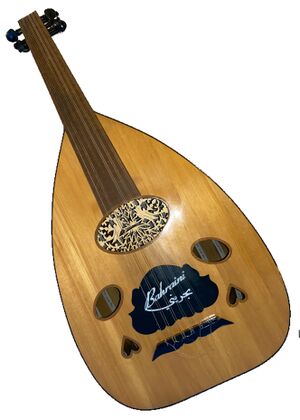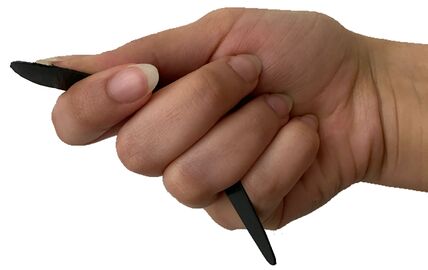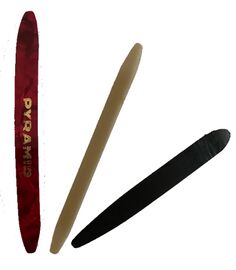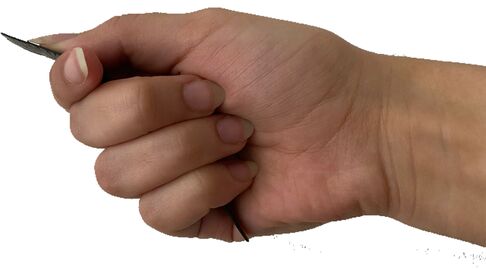Course:Phys341 2020/Oud
The Oud (Arabic: عود /‘ūd/, literally meaning wood) is readily distinguishable as a pear-shaped, fretless stringed instrument commonly used in Middle Eastern and Mediterranean music. Most accounts trace the Oud’s entrance into Europe through North Africa and into the Iberian Peninsula with the Umayyad Caliphate of Al-Andalus in 711 AD[1]. Ziryab, the founder of the first school of music in Spain, added the fifth course to the instrument. The instrument eventually grew frets and became le-oud, with the addition of the French definite article, resulting in the etymological and musical relative: lute.
Structure
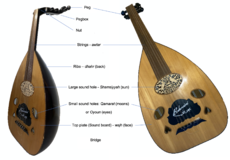
Proportions
In the 9th Century, Al-Kindi (a polymath often referred to as the father of Arab philosophy) described the body of the lute (Fig. 1) as a ball divided in two. A century later the Ikhwan Al-Safa encyclopaedia suggested the following harmonious proportions:
- the length must be one and a half times the width.
- the depth is half the width.
- the neck is one quarter of the length. If the neck measured only twenty cm (its approximate length today), the total length would be eighty cm, with or without the pegbox - an instrument much the same size as very large contemporary models.
Composition
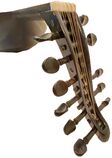
The pegbox is set at an angle to the fingerboard, and each string is individually wound to a manually adjustable peg (Fig. 2). Commercial Ouds typically have 11 strings with five courses (a set of adjacent strings tuned to the same note; for the Oud, there a 5 pairs of strings where both strings in a pair are tuned to the same note, and then a final, lone string, called bam in Arabic). In contrast with other instruments in the lute family, the Oud is a fretless instrument; this enables the production of a monochromatic range of sounds on an open frequency. The player must position their fingers on the fingerboard with precision to prevent off-key notes. Nylon strings are preferred for the two highest courses, while the other strings are made of metal wound with fine silk[2].
The fingerboard may serve as an indicator on the quality of the instrument[3]. A distinguishing factor between a true oud from an 'oud like' instrument is that a true Oud has a short neck that blends smoothly into the sound board profile (implying a one-piece, carved construction as opposed to a distinct neck joint).
The soundboard has the most important role in governing the sound quality of the Oud; the thinner the top plate, the more open the sound is. High-quality Ouds are conventionally made of 2mm thick, non-resinous pinewood sheets. Pinewood is the preferred material as it is a lightweight wood which reverberates when struck, allowing for techniques such as the tambora (percussive knock on the sound board under the bridge), and delivers the characteristic mellow timbre of the Oud.
The back is made from many joint strips of lightweight wood. A higher number of strips allows for more curvature and consequent production of deeper and softer sounds. The sound quality also correlates with the diversity in the types of wood used; this explains the elaborate attention paid to decorative inlay work[3].
Materials
While non-resinous pinewood is the material of choice, many types of wood are used to manufacture Ouds for reasons beyond sound quality (for instance, sandalwood is used for its aromatic quality).
- Walnut, larch, beech, cypress, pistachio, oak, mahogany, or rosewood for the back.
- Poplar, flame maple, or birds eye maple for the neck.
- Cedar, pine, or spruce for the sound board.
- Ebony fingerboards ensure smooth fretwork and low action.
- Genuine Mother-of-pearl or abalone fingerboard inlays.[3]
Tuning

The five-course oud is the most common in modern performances, as opposed to the four-, six-, or even seven-course models of the oud (Fig. 3). Oud tuning is highly dependent on the origin of the piece being played, which in turn is dependent on the musicians’ personal preferences. Tuning the strings to F2, A3, D3, G3, C3, F3, is becoming increasingly accepted as the standard form of tuning. The stabilisation of oud tuning is advocated by music schools in order to facilitate and standardise pedagogy. The justification behind the 'standard' tuning is that this covers the midrange octave of the piano, as well as the main octave of the human voice.
With the five-course model Oud, the heptatonic system imposes a complete series of octaves.
As the are fretless, Ouds are tuned to just temperament.
Ouds are tuned in accordance with the song’s style, or to the musician’s personal preference.
· (LOW) Arabian Ouds are tuned to D2 G2 A2 D3 G3 C4.[4]
· (HIGH) The Turkish Oud is commonly tuned to either C2 F2 B2 E3 A3 D4, or D2 A2 B2 E3 A3 D4.[4]
· (HIGHER) In Iraq, the C3 D3 G3 C4 F4 F2 tuning was popularised by Munir Bashir, known as the King of Oud.[1]
All tunings are similar in that they are tuned in fourths; the divergence in tuning patterns is particularly evident in the bam.
Playing the Oud
As a bass instrument, the range of the Oud is comparable to that of the guitar and the cello, except at an octave lower. When used as an accompaniment or in a performance, the Oud sets the rhythm with the alternately picked beats of the plectrum.
Plucking
The distance from the bridge and the angle at which the plectrum strikes the string both considerably affect the timbre (Fig. 6). The wealth of sonic possibilities enables performers to add contrast and tonal colour to their performances. It is generally preferable to play so the fingers of the right hand are over the sound hole. This produces the warm, soft, and balanced tone. Some musicians prefer the stronger twangy sound produced by playing close to the bridge in a position is called sul ponticello. By contrast, when the strings are plucked over the fingerboard (sul tasto) the tone becomes fuller. Since higher harmonics decay faster than lower harmonics, the timbre changes over time.
- Fig. 6. Risha types and grip methods affect the timbre of the Oud
-
(Own Work)
Plectrum (Risha)
The Oud is always played with a Risha: a flexible pick puts the wrist at a specific angle to the strings. A Risha is a flat stick typically measuring 100-180mm long and 6-10mm wide.[5]
The name Risha is an Arabic word literally meaning feather, and as such is conventionally manufactured from quill. Rishas may also be made of ivory, plastic, or tortoiseshell.
Acoustics
Sound Radiation Mechanism
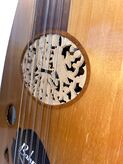
Sound radiation from an Oud is possible because of coupled oscillation in the cavity, where vibration coupling between the air in the sound hole and the wood of the sound board is radiated by the sound box (Fig. 4). Due to the thin wooden shell, the vibrational plates are less stiff, and result in a lower sound box vibration mode. Therefore, the sound box, in turn, modifies string spectrum according to the spectrum of vibrational modes of the sound box: the sound radiated by a thin sound box is at lower frequencies because of its vibration modes.
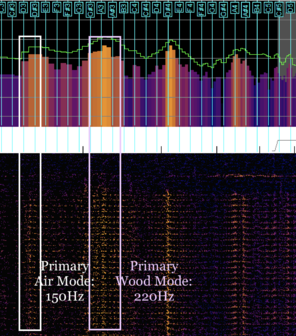
The position of the air mode under the fourth course characterises the Oud (in 'standard' tuning) as a bass instrument.
| String/Mode | Frequency |
|---|---|
| F2 | 87Hz |
| C3 | 130Hz |
| D3 | 147Hz |
| Primary Air Mode | ⩰150Hz |
| F3 | 174Hz |
| G3 | 199Hz |
| A3 | 203Hz |
| Primary Wood Mode | ⩰220Hz |
The cavity and body resonances are measured by damping the strings and striking the bridge. The open soundholes act as cavity (“Helmholtz”) resonators by creating an air-filled cavity that has a neck. Acoustic radiation is dominated by the lowest air and lowest wood modes at 150 and 220 Hz (Fig. 5). That is, without the soundholes, the pitch would go down significantly as the air in the cavity would act as a stiff spring and there would be no 150Hz resonance to support and radiate sound from the lower strings.
References
- ↑ 1.0 1.1 Kassel, Assaf (12 January 2016). "The Origin of the Oud". Arabic Instruments. Retrieved 19 March 2020.
- ↑ "Oud Strings". Just Strings. Retrieved 19 March 2020.
- ↑ 3.0 3.1 3.2 Abdoun, Seifed-din Shehadeh (1996). "The King of Arabic Instruments" (PDF). Retrieved 19 March 2020.
- ↑ 4.0 4.1 A, R (5 January 2018). "How to Play the Oud?". School of Oud Online. Retrieved 20 March 2020.
- ↑ Gonzalez, Pablo (16 December 2006). "Plectra (mizrab, risha, or simply "pick")". Pablo's Oud Page. Retrieved 20 March 2020.
